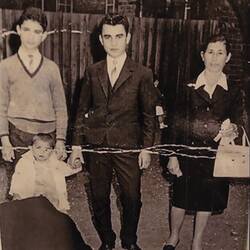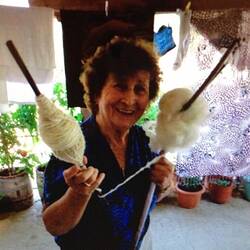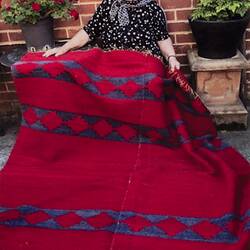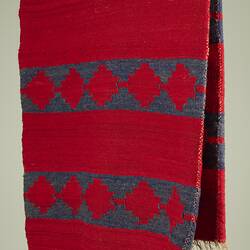Life in a Greek Village:
Efstathia (Effie) Spiropoulos was born in 1920 in a small village called Flessiada, on the outskirts of Kalamata in the Peloponnese in Greece. The village, being high in the mountains, was very isolated and as a result the people were very self-sufficient. They grew their own vegetables and made their own soap, cheese, yogurt, preserved their meat, cured their olives, dried their figs, made their own pasta and made their own household linen and blankets. The entire village had looms and the young women were busy weaving linen and blankets for their dowries.
The Museum's Blanket:
The beautiful red and blue blanket in the Museum's collection (HT 57396) is one that Effie wove for her dowry in 1938-1939 when she was about 19 years old, just before World War II. It was brought to Australia in 1964 when she migrated to Melbourne with her husband and their seven children in 1964. It is 174cm wide and 210cm in length.
The family donated the blanket to the Museum in 2022.
From Shearing to Spinning:
To make the blanket Effie first had to shear her sheep, wash the wool fibre and let it dry. Then she had to tease the wool using teasing brushes or hand carders to remove any debris and make it light and fluffy and ready for spinning. In Greek the hand carders are called 'Lanaria' (plura) or 'Lanari' (singular).
The wool was hand spun into yarn using distaffs and drop spindles. The distaff is a stick or spindle onto which wool is wound for spinning but unlike today, where a distaff or drop spindle can be purchased, the resourceful women of that generation cut branches, made it smooth to touch and used that for spinning.
Spinning was a constant task in Effie's daily life. Every spare moment she had was spent spinning in order to amass enough yarn to weave her blankets. Hand spinning was a time-consuming task especially considering that young women had to take care of the younger siblings as well as the elderly grandparents living with them. Effie also worked in the fields and tended to the animals that were essential to their livelihood. When she was a shepherdess she would make sure she had her hand-woven sack carrying her teased wool on a distaff and her spindle ready to go. While the sheep grazed Effie would pass every second of her time spinning. After she brought the sheep back, milked and settled them for the night, and once all her chores were completed, she would continue her spinning. She would tell her daughter Stavroula that in her day, a young woman was never idle, especially when there was spinning to be done.
From Spinning to Weaving:
Once enough yarn was accumulated the next step was to dye the yarn. The women dyed the homespun yarn with dyes purchased from peddlers or made their own dye from natural products such as walnut husk, beetroot and brown onion. Sometimes Effie would walk through mountainous terrain to the nearest town Chora, three hours away, to purchase the dye from the shops where there was a greater variety of colours. Effie often chose red and blue dyes for her blankets. She states that the women created their own patterns, but if they liked a pattern they saw on a blanket belonging to their grandparents, friends or relatives, they would count the threads and copy the pattern for future use.
Once the yarn was dyed, dried and the pattern selected the weaving was set to begin. The weaving loom 'aryalio' was wooden and bulky and took up a lot of space in the small house in the village. During the summer months the loom was set up outside to make it easier. Effie recalls that women wove only after working in the fields all day, tended to the livestock and completed all the daily household chores. Only then, were they free to start their weaving.
She remembers that she would frequently stay up until very late, weaving using an oil lamp 'Lihnari' to complete a section. Effie toiled for many hours making these precious hand-woven items. One particular night she was determined to finish a piece and stayed up all night when her aunt rushed through the door shouting 'The Germans are here! Run Efstathia! Run to the mountains and hide.' And she dropped everything and ran for her life.
Hand-Making Blankets - A Disappearing Art:
After the years of World War II and the Civil War, Effie had married and had children; but despite the hardships she always made time for her weaving. She had the dowries of four daughters to think about. But in the 1960s she remembers that women stopped weaving. Instead they took the fleece to the mill where it was spun and made into blankets for them. The industrial age had begun for this small, mountainous village in the Peloponnese. Effie still has many of these factory-made blankets neatly stacked on top of the wardrobe or 'baoulo'.
A Precious Memory Object:
For the Spiropoulos family, the blanket they donated to the Museum is very special. It symbolises their mother's youth and the difficult life she lived. It survived throughout the years due to the special care Effie always took with her belongings, treasuring the few possessions she had. In the family home these special hand-woven blankets were folded neatly and placed in a large storage trunk (a baoulo).
When the trunk was full, other items of value including more woven blankets, quilts (paplomata), fabrics, woven rugs (kilimi), tablecloths and other handmade rugs were carefully folded and layered one on top of the other to form an impressive stack (youko), perfectly aligned to match the exact dimensions of the storage trunk. Effie would often look at the youko and marvel at its contents.
Together with their mother and under her guidance, Stavroula and her three sisters would annually air out the precious items and reflect on their mother's extraordinary life.
More Information
-
Keywords
-
Authors
-
Article types





